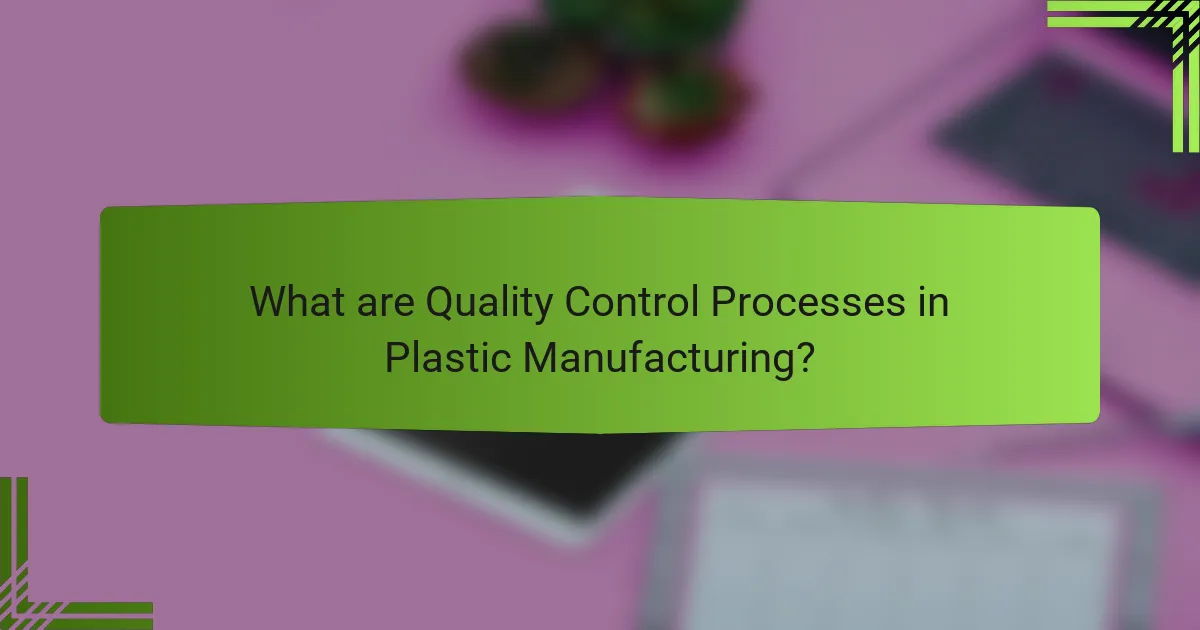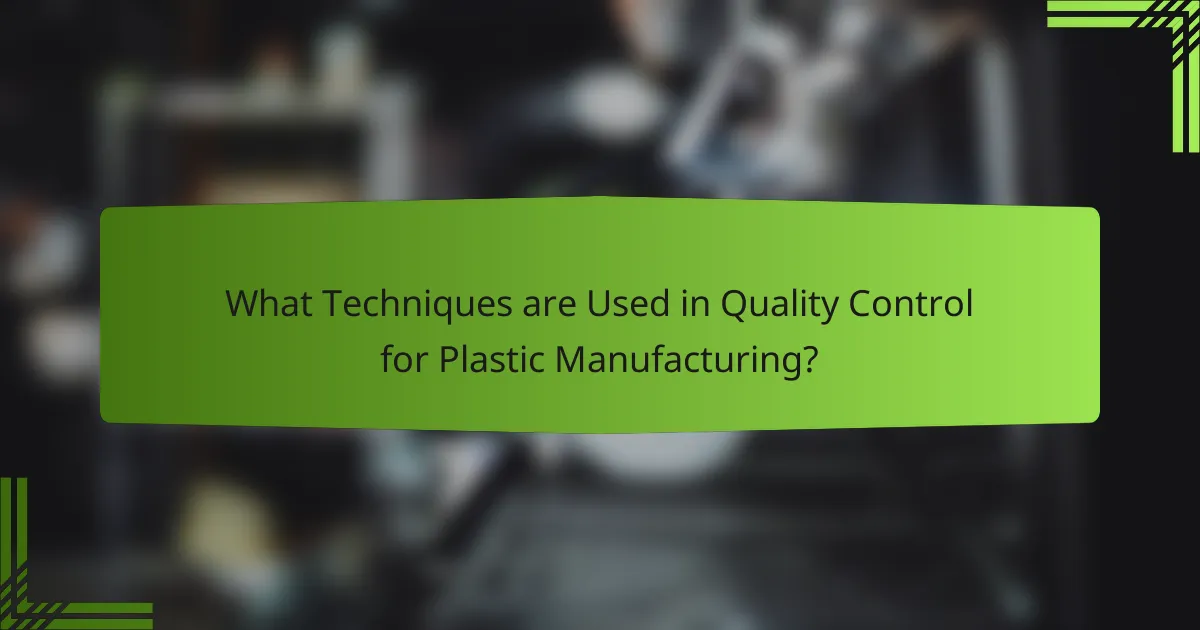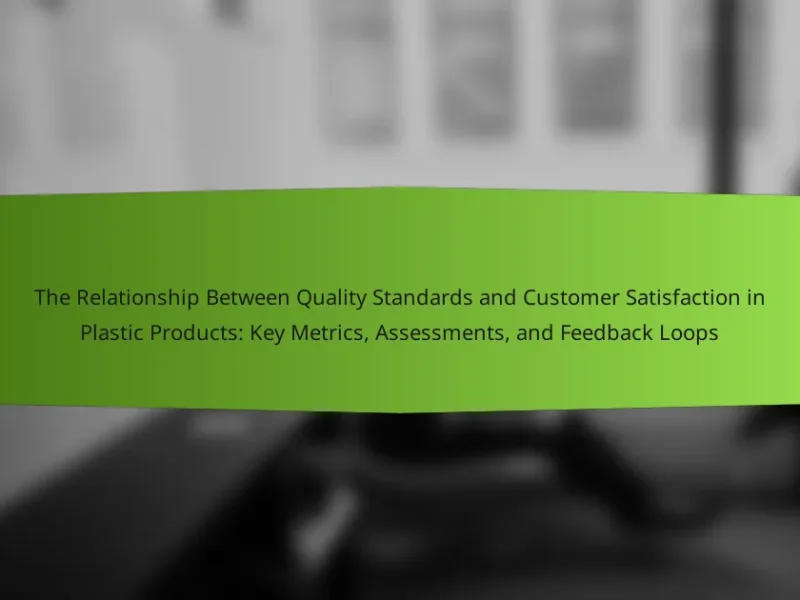Quality control processes in plastic manufacturing are systematic procedures designed to ensure product quality and compliance with specifications. Key techniques include visual inspections, dimensional measurements, and material testing, which help identify defects and verify product integrity. Essential tools such as calipers, micrometers, and tensile testing machines play a crucial role in maintaining quality standards. Best practices involve implementing standardized procedures, conducting regular inspections, and utilizing advanced testing methods to enhance product reliability and reduce waste. This overview highlights the importance of these processes in achieving customer satisfaction and meeting industry requirements.

What are Quality Control Processes in Plastic Manufacturing?
Quality control processes in plastic manufacturing are systematic procedures used to ensure product quality and compliance with specifications. These processes include inspection, testing, and monitoring of materials and products at various stages of production. Common techniques involve visual inspections, dimensional checks, and functional testing. Tools such as statistical process control (SPC) charts and quality management software are utilized to track performance. Best practices include establishing clear quality standards and conducting regular audits. These measures help identify defects early and reduce waste, ultimately leading to improved product reliability and customer satisfaction.
How do Quality Control Processes impact plastic manufacturing?
Quality control processes significantly impact plastic manufacturing by ensuring product consistency and reliability. These processes involve systematic inspections and testing at various stages of production. They help identify defects early, reducing waste and rework costs. According to a study by the American Society for Quality, effective quality control can decrease production costs by up to 30%. Implementing quality control measures also enhances customer satisfaction by delivering products that meet specifications. Additionally, compliance with industry standards is maintained through rigorous quality checks, which can lead to improved market competitiveness. Overall, quality control processes are essential for maintaining high standards in plastic manufacturing.
What are the key components of Quality Control Processes?
Key components of Quality Control Processes include standard operating procedures, inspection methods, and corrective actions. Standard operating procedures define the processes to ensure consistency. Inspection methods involve evaluating products against predefined criteria. Corrective actions address any deviations from quality standards. These components work together to maintain product quality in manufacturing. According to the American Society for Quality, effective quality control reduces defects and enhances customer satisfaction.
How do these components ensure product quality?
Quality control components ensure product quality by systematically monitoring and regulating manufacturing processes. These components include inspection tools, standardized procedures, and quality assurance protocols. Inspection tools detect defects and ensure compliance with specifications. Standardized procedures provide a consistent framework for production, reducing variability. Quality assurance protocols establish criteria for acceptable quality levels. Together, these components minimize errors and enhance product reliability. For example, implementing statistical process control can reduce defects by up to 50%, demonstrating the effectiveness of these quality control measures.
Why is evaluating Quality Control Processes essential?
Evaluating Quality Control Processes is essential to ensure product consistency and compliance with standards. It helps identify defects early in the manufacturing process. This reduces waste and saves costs associated with rework. Quality control evaluation also enhances customer satisfaction by delivering reliable products. According to a study by the American Society for Quality, organizations that focus on quality processes can reduce operational costs by up to 30%. Regular evaluation fosters continuous improvement and innovation within production lines. This ultimately leads to a more efficient manufacturing operation.
What risks are associated with inadequate Quality Control?
Inadequate Quality Control in plastic manufacturing poses significant risks. These risks include product defects, which can lead to customer dissatisfaction. Defective products may also result in costly recalls. Financial losses can occur due to increased warranty claims. Additionally, inadequate Quality Control can damage a company’s reputation. Regulatory non-compliance may lead to legal penalties. Production inefficiencies often arise from poor Quality Control processes. Ultimately, these risks can threaten the overall sustainability of a business.
How can effective evaluation improve manufacturing outcomes?
Effective evaluation improves manufacturing outcomes by identifying inefficiencies and enhancing product quality. It allows manufacturers to analyze processes systematically. This analysis leads to better resource allocation and reduced waste. For instance, companies that implement regular evaluations see a 15% increase in productivity. Evaluations also facilitate adherence to industry standards and regulations. By monitoring quality control measures, manufacturers can detect defects early. This proactive approach minimizes costly recalls and enhances customer satisfaction. Ultimately, effective evaluation fosters continuous improvement within manufacturing operations.

What Techniques are used in Quality Control for Plastic Manufacturing?
Techniques used in quality control for plastic manufacturing include visual inspection, dimensional measurement, and material testing. Visual inspection involves checking for defects such as surface blemishes or color inconsistencies. Dimensional measurement ensures that products meet specified tolerances using tools like calipers and micrometers. Material testing assesses properties like tensile strength and impact resistance through standardized tests. Statistical process control (SPC) monitors production processes using statistical methods to identify variations. Additionally, automated inspection systems use cameras and sensors for real-time quality assessment. These techniques help ensure that plastic products meet industry standards and customer expectations.
How do statistical methods contribute to Quality Control?
Statistical methods contribute to Quality Control by providing tools for data analysis and decision-making. These methods allow for the identification of variations in manufacturing processes. Control charts, for example, monitor process stability over time. They help detect trends that could indicate potential issues. Additionally, statistical sampling techniques assess product quality without inspecting every item. This approach saves time and resources while maintaining standards. Furthermore, hypothesis testing evaluates the effectiveness of changes in processes. By applying these methods, manufacturers can enhance product consistency and reduce defects. The use of statistical methods has been shown to improve quality outcomes significantly, as evidenced by studies in industrial settings.
What are the most common statistical techniques applied?
The most common statistical techniques applied in quality control processes include descriptive statistics, control charts, and hypothesis testing. Descriptive statistics summarize data through measures like mean, median, and standard deviation. Control charts monitor process stability over time, identifying variations that may indicate issues. Hypothesis testing evaluates assumptions about a population based on sample data, aiding in decision-making. Additionally, regression analysis explores relationships between variables, while design of experiments (DOE) optimizes processes. These techniques are essential for maintaining quality standards in plastic manufacturing. Each method provides valuable insights that enhance product consistency and reliability.
How do these techniques enhance product consistency?
These techniques enhance product consistency by standardizing processes and reducing variability. Standardization ensures that each product is manufactured under the same conditions. This leads to uniformity in dimensions, weight, and appearance. Reducing variability minimizes defects and inconsistencies in the final product. Techniques such as statistical process control (SPC) monitor production processes in real time. This allows for immediate adjustments to maintain quality. Additionally, regular calibration of machinery ensures equipment operates within specified tolerances. Consistent training for operators reinforces adherence to quality standards. Together, these methods produce reliable and repeatable results in plastic manufacturing.
What role do inspection techniques play in Quality Control?
Inspection techniques are essential in Quality Control as they ensure products meet specified standards. These techniques help identify defects and deviations in manufacturing processes. They include visual inspections, measurements, and testing methods. Each technique plays a role in assessing product quality at various stages. For example, visual inspections can quickly detect surface flaws. Measurement techniques ensure dimensions are within tolerance limits. Testing methods, such as stress tests, verify product performance. Studies show that effective inspection techniques reduce defect rates significantly. For instance, implementing statistical process control can lead to a 50% reduction in defects. Thus, inspection techniques are critical for maintaining quality and customer satisfaction in manufacturing.
What types of inspections are commonly performed?
Common types of inspections performed in plastic manufacturing include visual inspections, dimensional inspections, and functional testing. Visual inspections assess surface quality and identify defects such as scratches or discoloration. Dimensional inspections measure product specifications to ensure they meet design requirements. Functional testing evaluates the performance of the plastic parts under operational conditions. These inspections are essential for maintaining quality standards. According to the American Society for Quality, regular inspections can reduce defects by up to 50%.
How does each inspection type impact overall quality?
Each inspection type directly influences overall quality by identifying defects and ensuring standards are met. Visual inspections detect surface flaws, which can lead to immediate corrective actions. Dimensional inspections verify that products meet specified measurements, preventing issues in assembly. Functional testing assesses performance under operational conditions, ensuring reliability. Destructive testing provides insights into material properties, highlighting potential weaknesses. Non-destructive testing allows for thorough evaluations without damaging the product, preserving its usability. Each type of inspection contributes uniquely to maintaining high-quality standards in plastic manufacturing processes.

What Tools are essential for Quality Control in Plastic Manufacturing?
Essential tools for quality control in plastic manufacturing include calipers, micrometers, and tensile testing machines. Calipers measure dimensions accurately, ensuring parts meet specifications. Micrometers provide precise thickness measurements critical for product consistency. Tensile testing machines assess material strength and flexibility, confirming durability under stress. Additionally, visual inspection tools help identify surface defects. Automated inspection systems enhance efficiency by using cameras and sensors for real-time quality checks. Statistical process control software analyzes data trends, allowing for proactive adjustments. These tools collectively ensure that plastic products adhere to quality standards and specifications.
How do software tools facilitate Quality Control processes?
Software tools enhance Quality Control processes by automating data collection and analysis. They streamline the monitoring of production metrics in real-time. This automation reduces human error and increases accuracy in quality assessments. Software tools also provide dashboards for visualizing quality data trends. Such visualization aids in quick decision-making and identifying issues promptly. Furthermore, these tools facilitate compliance with industry standards through documentation and reporting features. They enable traceability of materials and processes, ensuring accountability. Overall, the integration of software tools leads to improved efficiency and effectiveness in Quality Control processes.
What features should be considered when selecting Quality Control software?
When selecting Quality Control software, consider features such as data analysis capabilities, user-friendly interface, and integration with existing systems. Data analysis capabilities allow for effective monitoring of quality metrics. A user-friendly interface enhances ease of use for staff. Integration with existing systems ensures seamless data flow across platforms. Additionally, look for customizable reporting options to meet specific needs. Real-time monitoring is crucial for timely decision-making. Support and training services are important for effective software implementation. Scalability should also be evaluated to accommodate future growth.
How do software tools integrate with manufacturing systems?
Software tools integrate with manufacturing systems through data exchange and process automation. They connect various components, such as machinery, sensors, and databases. This integration allows for real-time monitoring of production processes. It enhances efficiency by streamlining workflows and reducing manual errors. Software tools can analyze data to identify trends and improve quality control. They often utilize APIs to communicate with existing manufacturing systems. For example, Enterprise Resource Planning (ERP) systems manage resources and inventory effectively. Research indicates that companies using integrated software tools see productivity increases of up to 20%.
What physical tools are important for Quality Control?
Calipers, micrometers, and gauges are important physical tools for Quality Control. Calipers measure the distance between two opposite sides of an object. They provide precise measurements for thickness, diameter, and depth. Micrometers offer even finer measurements, often to the thousandth of a millimeter. Gauges, such as go/no-go gauges, help ensure parts meet specific tolerances. These tools are essential in plastic manufacturing to maintain product quality. Accurate measurements prevent defects and ensure compliance with specifications. Quality Control processes rely heavily on these tools for effective monitoring and evaluation.
What types of measuring instruments are commonly used?
Commonly used measuring instruments in plastic manufacturing include calipers, micrometers, and gauges. Calipers are essential for measuring dimensions with high precision. Micrometers provide accurate thickness measurements, often down to microns. Gauges are utilized for checking tolerances and fit. Other instruments include laser measurement systems and coordinate measuring machines (CMM). Laser systems offer non-contact measurement for complex shapes. CMMs provide detailed dimensional analysis of parts. These instruments are critical for ensuring quality control in production processes. Their use helps maintain standards and specifications in plastic manufacturing.
How do these tools ensure accurate measurements?
These tools ensure accurate measurements through precise calibration and advanced technology. Calibration involves adjusting the tool to meet specific standards, ensuring reliability. Advanced technology, such as laser measurement systems, provides high precision and minimizes human error. Regular maintenance further enhances accuracy by preventing wear and tear. Data validation processes confirm that measurements are consistent and within acceptable ranges. Statistical process control techniques monitor the measurement process over time. These methods collectively guarantee that measurement tools produce reliable and accurate data in plastic manufacturing quality control.

What are the Best Practices for Quality Control in Plastic Manufacturing?
The best practices for quality control in plastic manufacturing include implementing standardized procedures, conducting regular inspections, and utilizing advanced testing methods. Standardized procedures ensure consistency in production and minimize errors. Regular inspections help identify defects early in the manufacturing process. Advanced testing methods, such as tensile and impact testing, assess the material properties of plastics. Additionally, maintaining clear documentation of quality control processes aids in traceability and compliance. Training employees on quality standards fosters a culture of quality within the organization. Utilizing statistical process control techniques allows for real-time monitoring and adjustments. These practices collectively enhance product quality and reduce waste in plastic manufacturing.
How can manufacturers foster a culture of quality?
Manufacturers can foster a culture of quality by implementing continuous improvement practices. This involves regularly assessing processes and outcomes to identify areas for enhancement. Training employees on quality standards is essential. Empowering staff to take ownership of quality issues promotes accountability. Encouraging open communication about quality concerns helps in addressing problems early. Recognizing and rewarding quality achievements motivates teams. Utilizing data analytics can provide insights into quality performance. Establishing clear quality objectives aligns organizational efforts towards common goals.
What training programs are effective for quality awareness?
Effective training programs for quality awareness include Six Sigma, ISO 9001 training, and Total Quality Management (TQM) workshops. Six Sigma focuses on process improvement and reducing defects. ISO 9001 training emphasizes quality management systems and compliance standards. TQM workshops promote a culture of continuous improvement and customer satisfaction. These programs have been proven to enhance understanding of quality principles. They also foster a proactive approach to quality control. Implementing such training can lead to measurable improvements in manufacturing processes. Organizations that adopt these programs often report higher product quality and customer satisfaction.
How does employee engagement contribute to quality improvement?
Employee engagement significantly contributes to quality improvement by fostering a culture of accountability and innovation. Engaged employees are more likely to take ownership of their work. This sense of ownership leads to increased attention to detail and adherence to quality standards. Research indicates that companies with high employee engagement see a 20% increase in productivity. Furthermore, engaged employees are more inclined to share ideas for process enhancements. This collaborative approach often results in innovative solutions that improve product quality. In the context of plastic manufacturing, engaged workers can identify defects early in the production process. Early detection minimizes waste and reduces costs associated with rework. Overall, employee engagement drives a commitment to continuous improvement in quality.
What common challenges do manufacturers face in Quality Control?
Manufacturers face several common challenges in Quality Control. One challenge is maintaining consistent product quality. Variations in raw materials can lead to inconsistencies. Another challenge is the complexity of inspection processes. Advanced manufacturing techniques often require sophisticated testing methods. Additionally, manufacturers struggle with compliance to industry standards. Failure to meet regulations can result in penalties. Resource limitations also pose a significant challenge. Many manufacturers lack sufficient personnel for thorough quality checks. Lastly, integrating technology into Quality Control can be difficult. Legacy systems may not easily adapt to new software or tools. These challenges can hinder overall efficiency and product reliability.
How can these challenges be effectively addressed?
Challenges in quality control processes in plastic manufacturing can be effectively addressed by implementing standardized procedures. Standardization ensures consistency in production and quality assessment. Training employees on these procedures enhances their understanding and execution. Utilizing advanced inspection tools, such as automated vision systems, improves defect detection rates. Data analytics can help identify trends and root causes of quality issues. Regular audits of quality control processes ensure compliance and continuous improvement. Collaborating with suppliers on quality standards fosters a unified approach to quality. These strategies are supported by industry studies showing improved outcomes in manufacturing efficiency and product quality.
What are some troubleshooting tips for maintaining quality?
To maintain quality in plastic manufacturing, implement regular equipment calibration. This ensures machinery operates within specified tolerances. Conduct routine inspections of raw materials for defects. Quality raw materials are essential for consistent production. Monitor environmental conditions such as temperature and humidity. These factors can influence material properties. Train staff on quality standards and procedures. Skilled employees can identify and resolve quality issues promptly. Utilize statistical process control (SPC) techniques to analyze production data. SPC helps in identifying trends and variations in quality. Document all quality control processes thoroughly. This creates a reference for troubleshooting future issues.
The main entity of this article is Quality Control Processes in Plastic Manufacturing. The article provides a comprehensive overview of the systematic procedures used to ensure product quality and compliance with specifications, including inspection, testing, and monitoring techniques. Key components such as standard operating procedures, inspection methods, and corrective actions are discussed, highlighting their role in maintaining product consistency and reliability. Additionally, the article addresses the importance of evaluating quality control processes, the risks associated with inadequate quality control, and various tools and best practices that enhance manufacturing outcomes. Techniques, such as statistical methods and automated inspection systems, are also covered to illustrate their impact on product quality and efficiency.


